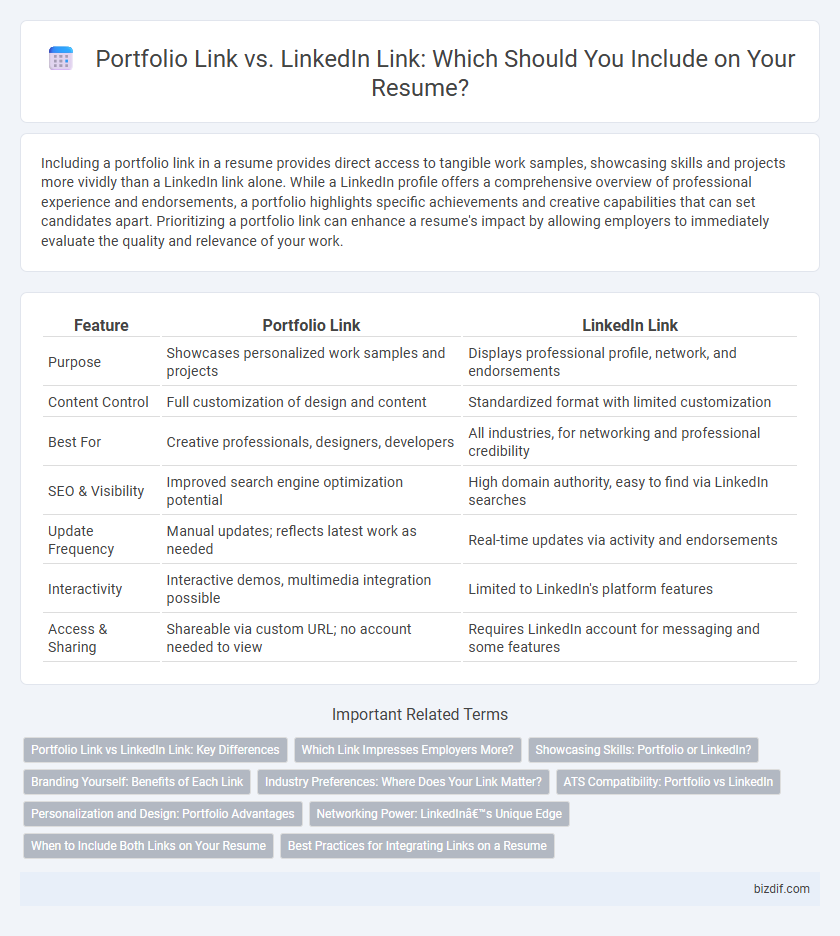Including a portfolio link in a resume provides direct access to tangible work samples, showcasing skills and projects more vividly than a LinkedIn link alone. While a LinkedIn profile offers a comprehensive overview of professional experience and endorsements, a portfolio highlights specific achievements and creative capabilities that can set candidates apart. Prioritizing a portfolio link can enhance a resume's impact by allowing employers to immediately evaluate the quality and relevance of your work.
Table of Comparison
| Feature | Portfolio Link | LinkedIn Link |
|---|---|---|
| Purpose | Showcases personalized work samples and projects | Displays professional profile, network, and endorsements |
| Content Control | Full customization of design and content | Standardized format with limited customization |
| Best For | Creative professionals, designers, developers | All industries, for networking and professional credibility |
| SEO & Visibility | Improved search engine optimization potential | High domain authority, easy to find via LinkedIn searches |
| Update Frequency | Manual updates; reflects latest work as needed | Real-time updates via activity and endorsements |
| Interactivity | Interactive demos, multimedia integration possible | Limited to LinkedIn's platform features |
| Access & Sharing | Shareable via custom URL; no account needed to view | Requires LinkedIn account for messaging and some features |
Portfolio Link vs LinkedIn Link: Key Differences
A portfolio link provides a curated, visual showcase of your work, tailored to highlight specific projects and skills, making it ideal for creative roles such as design, writing, or development. A LinkedIn link offers a comprehensive professional profile, including endorsements, recommendations, work history, and networking opportunities, beneficial for demonstrating credibility and career progression. While portfolios emphasize tangible outputs and hands-on capabilities, LinkedIn focuses on professional reputation, connections, and industry engagement.
Which Link Impresses Employers More?
Employers often find a well-crafted portfolio link more impressive than a LinkedIn profile because it provides tangible evidence of skills and projects, showcasing real-world applications and creativity. A portfolio link allows candidates to display detailed case studies, design work, coding samples, or writing pieces that highlight their expertise beyond the resume. While LinkedIn is essential for professional networking and endorsements, portfolios deliver concrete proof of capability, making a stronger impact in fields like design, IT, marketing, and writing.
Showcasing Skills: Portfolio or LinkedIn?
A portfolio link offers a tangible showcase of projects, designs, and work samples, providing employers with direct evidence of skills and creativity. A LinkedIn link highlights professional experience, endorsements, and recommendations, reflecting a candidate's industry reputation and network. Choosing between a portfolio and LinkedIn link depends on whether demonstrating hands-on skills or professional credibility is more critical for the target job.
Branding Yourself: Benefits of Each Link
Including a portfolio link on your resume provides tangible evidence of your skills and projects, showcasing your unique style and professional accomplishments directly to potential employers. A LinkedIn link enhances personal branding by offering a comprehensive overview of your professional network, endorsements, and detailed work history, reinforcing credibility and industry connections. Leveraging both links strategically can create a well-rounded personal brand, combining visual proof of expertise with social validation and career growth opportunities.
Industry Preferences: Where Does Your Link Matter?
In tech and creative industries, a portfolio link showcasing projects and skills holds greater value for recruiters, demonstrating practical experience and design capabilities. Conversely, in corporate sectors such as finance or marketing, a well-curated LinkedIn profile emphasizing professional network, endorsements, and career progression is often preferred. Understanding industry preferences helps tailor your resume links to enhance credibility and hiring potential effectively.
ATS Compatibility: Portfolio vs LinkedIn
Including a portfolio link in a resume enhances ATS compatibility by providing direct access to visual work samples without relying on external platforms. LinkedIn links may not always be optimized for ATS parsing, as ATS systems often prioritize traditional resume content over social media profiles. Incorporating a portfolio link ensures recruiters and ATS software can easily evaluate tangible skills and projects, improving overall resume effectiveness.
Personalization and Design: Portfolio Advantages
A personalized portfolio link offers superior design flexibility, allowing candidates to showcase their unique style and creativity beyond LinkedIn's standardized format. Custom portfolios enable the inclusion of multimedia elements, detailed project descriptions, and interactive features that tailor the presentation to specific job roles. This level of customization enhances employer engagement by providing a distinctive and memorable experience compared to generic LinkedIn profiles.
Networking Power: LinkedIn’s Unique Edge
LinkedIn's networking power surpasses a traditional portfolio link by offering direct access to professional connections, endorsements, and real-time industry updates that enhance visibility and credibility. Unlike static portfolios, LinkedIn profiles enable dynamic interaction through messaging, group participation, and content sharing, facilitating relationship-building and job opportunities. Recruiters prioritize LinkedIn links for its comprehensive snapshot of applicants' skills, recommendations, and career trajectories within an active professional ecosystem.
When to Include Both Links on Your Resume
Include both a portfolio link and a LinkedIn link on your resume when applying for roles in creative industries or technical fields where showcasing work samples is crucial alongside professional networking credibility. A portfolio link highlights your tangible skills and project experience, while a LinkedIn profile provides detailed career history, endorsements, and networking potential. Use clear, concise hyperlink text and position both links prominently to maximize recruiter engagement and demonstrate comprehensive professional branding.
Best Practices for Integrating Links on a Resume
Including a portfolio link on a resume is essential for showcasing tangible work samples, especially in creative and technical fields, while a LinkedIn link provides a comprehensive professional profile and networking opportunities. Best practices include placing these links in the header or contact section for easy visibility and using customized URLs to maintain a clean, professional appearance. Ensuring both links are active, up-to-date, and align with the job application enhances credibility and facilitates seamless access for recruiters.
Portfolio link vs LinkedIn link Infographic

 bizdif.com
bizdif.com